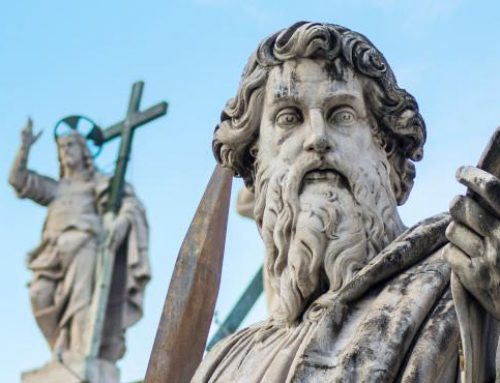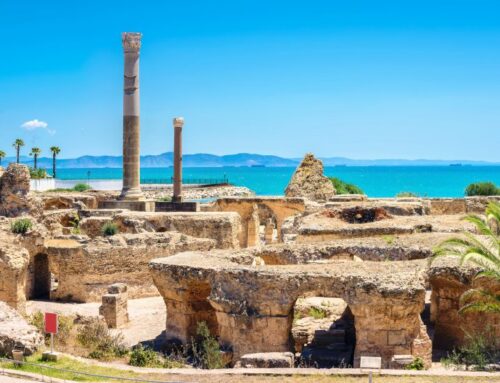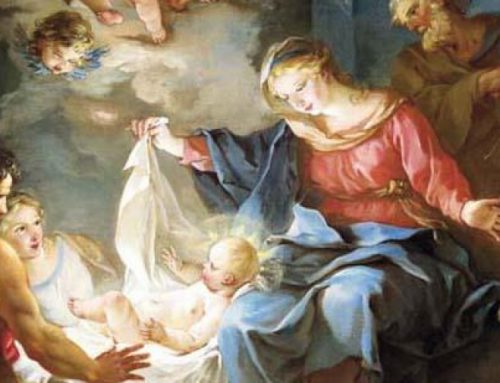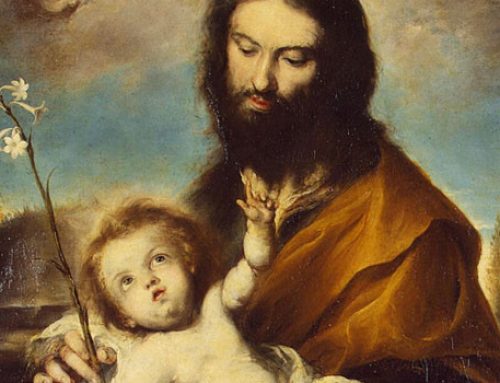The early Christians had an interior liveliness and hope that transformed the world
A small group of men and women once set its principles of charity and temperance against the prevailing values of the age—and in so doing altered the course of civilization. Because the early Christians’ belief had a specific content of truth and morality based on the life and teachings of Jesus Christ, they could not simply go with the flow. Jesus was both God and man. They could not worship, or pretend to worship, a mere human being who claimed to be God because he was Caesar. And this seemed to non-Christians to be an unpardonable stubbornness and perversity.
Marriage and Family Matter
This “stubbornness” was not simply confined to matters of worship. The Christians’ family customs were an affront to their pagan neighbors. They would not practice artificial birth control or abortion (the Greeks and Romans had primitive forms of these) since they believed in both the sanctity of life and the life-giving process.
Christian couples did not divorce or have sex before marriage because they believed that sexual intercourse was for marriage only, and that the unity of man and woman in marriage was sacred and indissoluble: It was a reflection of Christ’s own unity with his bride the Church (cf. Eph. 5:25). In an age when any father could command the death of his newborn child, Christians accepted all children, including those who were weak or handicapped. In the words of an early Christian testimony, probably written in the second century:
Christians . . . marry like all others, and beget children; but they do not expose their offspring. Their board they spread for all, but not their bed. They find themselves in the flesh, but do not live according to the flesh. They spend their days on earth, but hold citizenship in heaven. (Letter to Diognetus, qtd. in Johannes Quasten, Patrology, 250)
Christians even went to the street corners of cities like Rome and Corinth and took into their homes the infants that had been abandoned there. No wonder the numbers of Christians spread so rapidly, while the numbers of pagan families diminished.
Christians were married in Roman civil ceremonies but believed that they were receiving a sacrament that bound them to each other in fidelity for all of their lives. In the words of Tertullian, Christian married couples are people “who sustain one another in the way of the Lord, who pray together, who go together to God’s table, and who face all their ordeals together” (qtd. in Henri Daniel-Rops, The Church of the Apostles and Martyrs, 233).
Certain heretical groups, like the Gnostics and the Encratists, scorned marriage and children; they considered matter evil and opposed to their intellectual liberation. They were condemned by the first generation of Christian writers who were loyal to the Church, particularly St. Irenaeus of Lyons and Clement of Alexandria.
Many Christian women were married to pagan men; these women had a tremendous capillary effect on pagan society because they raised their children in the faith and because often their husbands converted. Consider the immense influence that St. Monica had on her husband and sons, especially Augustine. Monica’s story was lived by thousands of women in many different times and places for five centuries. As a result Christian marriage literally produced a new race of people, with a completely different view of life and love, who revolutionized the ancient world.
Pray without Ceasing
The prayer life of the first Christian disciples was continuous and intense. In part they shared this with all the ancients, who in general had a much greater awareness of the sacred and supernatural than people of the modern world, dulled by centuries of rationalism and empiricism. Christians inherited the Judaic belief in the angels and spoke of them in a very spontaneous way as frequently acting upon earth and individuals (cf. Acts 12:15). These spiritual beings provide continual and often hidden service for leading a virtuous life.
For example, The Shepherd of Hermas, an early second-century document, speaks of the “angel of righteousness” guiding every person (Bk. II, Command. 6, 2). The Christians prayed to the saints and venerated their relics and place of burial, believing in their intercessory power before God. They did so with a firm conviction that all of them, living or deceased, were united in the one Body of Christ.
The desire for God’s constant presence also applied to their daily work and other activities. St. John Chrysostom, writing in the fourth century, described the conversion of a Christian’s work into prayer in this way:
A woman busy in her kitchen, or sewing some cloth can always lift her thoughts to heaven and invoke the Lord with fervor. One who goes to the market or travels alone can easily pray attentively. Another in his wine cellar, busy sewing wineskins, is free to raise his heart to the Master . . . No place is lacking in decorum for God. (4th Homily on Anna, Mother of the Prophet Samuel, 6)
The historical and spiritual root of this attitude is the life of Christ himself, who had spoken many times in his parables of ordinary life and its intimate connection to the kingdom of God. Jesus, too, led a life of humble labor. In his hometown of Nazareth he was simply known as “the carpenter, the son of Mary” (Mark 6:3).
Be in the World, Not of It
We see no evidence in the earliest centuries of Christianity of any desire to leave the world. Instead, they considered it a mandate of Christ to change the society around them. As Jesus said to his followers: “I do not pray that you take them out of the world, but that you keep them from evil” (John 17:15). They lived the mandate given by Christ to his apostles: “Go therefore and make disciples of all nations” (Matt. 28:19).
After converting, they remained where they were, with their families and their occupations, and if they were slaves, with their masters. Except for their clean living and charity, they distinguished themselves in no way from their neighbors. As one second-century document puts it:
Christians are not distinguished from the rest of mankind by either country, speech, or customs; the fact is, they nowhere settle in cities of their own; they use no particular language; they cultivate no eccentric mode of life . . . To say it briefly: What the soul is in the body, that the Christians are in the world. The soul is spread through all the members of the body, and the Christians throughout the cities of the world. (Letter to Diognetus, qtd. in Quasten, Patrology, 250-251)
Not until the end of the third century do we see the beginnings of the monasticism among some people in the Church: that of leaving the world in a permanent way in order to pray or give oneself to God.
See How They Love One Another
Above all, the early followers of Christ showed an understanding and kindness to one another and to non-Christians that astounded the ancient world—a world often constructed on power, money, and cruelty. Though there were noble pagans who believed in personal discipline and stoic acceptance of adversity, their virtue was based on human efforts alone and often led to a feeling of sterility and helplessness. (See “Suffering and Death Have Meaning,” right.)
But Christian fortitude had a twofold source. First, Christians were aware of the grace that came to them from baptism, a grace which made them children of God and gave them a power not dependent on human efforts or lineage (cf. John 1:12). Second, they shared the conviction that no Christian was isolated from another and that all of them—whether rich or poor, noble or slave, educated or uneducated—were equally loved and valued by Jesus Christ.
Together the communities formed what the Catholic Church would later call the Mystical Body of Christ, in which each member, no matter how small, had an important contribution to make. This desire for unity in both joys and sorrows meant that Christians were unafraid even to die for another or with another—as in the famous case of the Martyrs of Sebaste, where 40 Roman soldiers died together in a frozen lake to seek 40 crowns from Christ the King.
The best of pagans, such as Marcus Aurelius and Seneca, treated their slaves with respect and humanity—even giving them their freedom upon occasion—but the followers of Christ went much further than that. We can see this in the Letter of Paul to Philemon, where he entreats his friend to accept the return of the runaway slave Onesimus.
As a result, “See how they love one another” was the continual astonished cry of the pagans around them. This charity, or agape, the reality of “being one body in Christ” was rooted in the Eucharist. Instituted at the Last Supper, it united the entire community in Jesus’ sacrifice; it was in his body and blood that they found hope and strength. (See “We Cannot Live without the Eucharist,” page 10.)
Put to Death Desires of the Flesh
Those of the Way (an early name for Christians) did not go to the gladiatorial games or to the extravagant parties held by their countrymen, which often included drunkenness and sexual immorality. And the Christians’ moral steadfastness, along with their refusal to offer incense to Caesar’s statue, made them despised and persecuted.
They were called “obstinate and superstitious,” and all kinds of strange tales were fabricated about them: that they ate their own children, that they worshipped a man with a donkey’s head on a cross, that they turned out the lights in their gatherings and did immoral things. (This last story began probably because many Christians attended a vigil service on Saturday evenings as a way to prepare for the celebration of Jesus’ Resurrection the next day.)
Many communities of Christians were inspired by the words of Paul to the Romans: “[I]f you live according to the flesh you will die, but if by the Spirit you put to death the desires of the body you will live” (Rom. 8:13). That strong term “put to death” was translated later in Latin asmortificare, from which we derive the word mortification.
As Christ’s first followers were so close chronologically to his death, they desired to experience his death in their lives and so to share in his triumph forever. “For you have died,” Paul wrote, “and your life is hidden with Christ in God. When Christ, your life, shall appear, then you too will appear with him in glory” (Col. 3:3-4).
Consequently, the first men and women disciples offered many voluntary sacrifices and penances. Catechumens preparing for baptism would fast for 40 days in imitation of Christ’s fast in the desert before his public ministry—the origin of the observance of Lent. Other days of special fasting called Ember Days were prescribed for Christians in Rome during June, September, and December, in preparation for the great feasts of Pentecost, the Exaltation of the Cross, and Christmas.
Because they valued so greatly what conversion and baptism had done for them, the Christians’ penances for the sacrament of reconciliation were severe by modern standards. Absolution for grave sins could be preceded by long periods of fasting and wearing sackcloth.
Early believers also may have used many personal means of mortification, but we have no historical record because a key element of mortification is that it should be private (except in the case of public sinners seeking pardon). Jesus exhorted his followers to personal, hidden mortification in Matthew 6:16-18, where he states that mortification unseen to men is more pleasing to God: “Your Father who sees in secret will reward you.”
For instance, the use of hair shirts, inspired by Old Testament heroes and by St. John the Baptist, dates back to the most ancient days of the Church, when they were worn by both priests and laity. Sts. Jerome, Athanasius, and John Damascene all bear witness to this practice. The hair shirt, and its later form, the cilice, continued to be worn in succeeding centuries by Christian laymen and members of religious orders.
Rejoice in Divine Filiation
In a tired and sad ancient world, burdened by skepticism, the early Christians were noted for their joy. This joy was essential for the Christian revolution: No pagan religion could match the sheer happiness of the followers of Christ. It was not a superficial or giddy kind of contentment, but a deep conviction that they were daughters and sons of God. Even though they could be killed at any time, they should not be afraid of anything or anyone. At the root of that conviction lay the power of baptism and sacramental life, which inserted them into the very life of God’s Son.
In the prologue to his Gospel, written towards the end of the first century, John expressed how this deep relationship gives meaning and hope to Christian lives: “But to as many as received him he gave the power of becoming sons of God: to those who believe in his name: who were born not of blood, nor of the will of the flesh, nor of the will of man, but of God” (John 1:12-13).
The first Christians’ dignity and hope, therefore, did not lie in their social status, wealth, or family connections—many Christians were slaves or shopkeepers—but in their personal relationship with Christ, who introduced them to the glory of his Father and the love of the Holy Spirit. Through this personal relationship they experienced an interior freedom and confidence which gave them both hope and joy. “Now you have not received a spirit of bondage so as to be again in fear, but you have received a spirit of adoption as sons” (Rom. 8:15).
To non-Christians this behavior seemed to be a kind of madness; they could not understand its cause, nor its ultimate meaning. To many pagan philosophers, such as the Stoic Emperor Marcus Aurelius, it was troubling. Yet as the years went by, this new way of thinking and acting—this new way of being—slowly changed the ancient world.
The Church Is Young
What can we say about Christianity both from a historical and prophetic point of view as we look towards the future? The Acts of the Apostles was written within 50 years of Christ’s death. It attests that the Holy Spirit, beginning at Pentecost, performed wonders in human lives. In the two centuries following Pentecost, the pattern and model for the Church was established for all times, in the life, sufferings, hopes, and joys of those first generations of Christian men and women.
We have no reason to doubt that the Holy Spirit continues to work in the Church, giving her a perennial youthfulness. We experienced a hint of the unity and gladness of those first enthusiasts for Christ in very recent times, in the days surrounding the passing of Pope John Paul II and the election of Pope Benedict XVI. There was, as one person put it, a kind of “electricity” in the air.
The early Christians had an interior liveliness and hope that transformed the world. There is good reason to believe that could happen again in our 21st-century world. Perhaps it is already happening. Pope Benedict seemed to imply as much in his April 2005 inaugural homily. “Yes the Church is alive,” he said, “this is the wonderful experience of these days . . . And the Church is young. She holds within herself the future of the world and therefore shows each of us the way toward the future.”
Suffering and Death Have Meaning
A fatalism in Greco-Roman thought often crushed the chance for any real personal hope, or any final victory for human beings in their short lives. Thus, many classical tragedies are based on the utter chaos and despair produced by the fates, the forces of nature, and the machinations of the gods and goddesses either for or against mankind.
Pope Benedict XVI makes this one of the central observations in his recent encyclical Spe Salvi (We Are Saved in Hope). In the end, the wise pagan can only suffer patiently, without understanding the reason for suffering. But Christians looked at pain and suffering in a completely different way: They believed firmly in a life beyond death and in the positive value of suffering. “For those who love God, all things work together for the good,” Paul of Tarsus wrote (Rom. 8:28).
Suffering, rejection, sickness, even death had meaning for them, since all of these connected them with the suffering and victory of Christ crucified. Because of this, Christians did not live in a chaotic, hopeless universe but in a world that reflected God’s love for them and his ultimate victory over sin and death. For this reason they could practice charity in an extraordinary way, treating slaves as their brothers and sisters in Christ.
We Cannot Live without the Eucharist
For an early Christian to miss the Sunday Eucharist was unthinkable. At the beginning of the fourth century, 49 Christians in northern Africa went to their deaths rather than miss the weekly Mass (Cf. Message of the XI Ordinary General Assembly of the Synod of Bishops on the Eucharist, October 22, 2005). “We cannot live without the Eucharist” was a statement repeated by early Christians.
St. Justin Martyr, who taught in Rome between A.D. 140 and 165, wrote one of the earliest accounts of the Mass. It had essentially the same structure as it has today: gathering of the faithful, readings from the inspired books, homily or exhortation, offering of gifts, eucharistic prayer, reception of Communion, final dismissal.
It was in the Eucharist that these early believers participated most intimately in the life and sacrifice of Christ, sharing in the power of their God which then overflowed into the rest of their day. This conviction and practice was so strongly rooted in them that not until later times—when some Christians began to grow lax in their worship—did the Church institute the law of Sunday observance, binding under grave sin.
Father Michael Giesler in Catholic Answers








Leave A Comment
You must be logged in to post a comment.